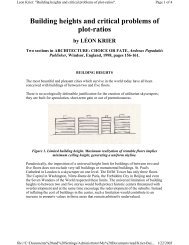NFPA Chemical Hazard Label Coding - FAMU SOA Home
NFPA Chemical Hazard Label Coding - FAMU SOA Home
NFPA Chemical Hazard Label Coding - FAMU SOA Home
Create successful ePaper yourself
Turn your PDF publications into a flip-book with our unique Google optimized e-Paper software.
<strong>NFPA</strong> <strong>Chemical</strong> <strong>Hazard</strong> <strong>Label</strong>The National Fire Protection Association (<strong>NFPA</strong>) has developed a color coded, numerical system for indicating thehealth, flammability and reactivity hazards of chemicals. In addition, a special precaution symbol may be used ifnecessary.<strong>NFPA</strong> labels are required on all chemicals in the laboratory. Some chemicals that we purchase already have thesemarkings (or their equivalents) on the container. Other ones don't have such markings and should have a <strong>NFPA</strong> labelput on them immediately.To assist you in assessing the degree and type of hazard associated with a particular substance, we have providedthese guidelines for you to follow.Degree of <strong>Hazard</strong>sEach of the three colored areas in the <strong>NFPA</strong> fire diamond has a box in which the degree of hazard can be written. Thedegree of hazard is given by these numbers:NumberDegree of <strong>Hazard</strong>4 EXTREME3 SERIOUS2 MODERATE1 SLIGHT0 MINIMAL
Types of <strong>Hazard</strong>sThe diamond is subdivided into four general categories:1. Health (blue)2. Flammability (red)3. Reactivity (yellow)4. Special (white)For each class of materials, here are guidelines and examples to help you assign or understand a hazard rating:4 ExtremeHighly toxic material. Will have one or more of thefollowing characteristics:On very short exposure could cause death or majorresidual injury even though prompt medical treatmentis given.A known or suspected human carcinogen, mutagenor teratogen.3 SeriousToxic material. Will have one or more of thefollowing characteristics:May cause serious temporary or residual injury onshort term exposure even though prompt medicalattention is given.A known or suspected small animal carcinogen,mutagen or teratogen.
Will burn in air when exposed at 1500 F (815.5 C)for 5 minutes.Flash point at or above 200 F (93.4 C).0 MinimalWill have one or more of the followingcharacteristicsWill not burnWill not exhibit a flash pointWill not burn in air when exposed at 1500 F (815.5C) for 5 minutes.4 ExtremeWill have one or more of the followingcharacteristicsCan explode or decompose violently at normaltemperature and pressure.Can undergo a violent self-accelerating exothermicreaction with common materials or by itselfMay be sensitive to mechanical or local thermalshock at normal temperature and pressure.3 SeriousWill have one or more of the followingcharacteristics:Can detonate or explode but requires a stronginitiating force or confined heating before initiationReadily promotes oxidation with combustiblematerials and may cause firesIs sensitive to thermal or mechanical shock atelevated temperatures.May react explosively with water without requiringheat or confinement.2ModerateWill have one or more of the followingcharacteristics:Normally unstable and readily undergoes violentchange but does not detonate.May undergo chemical change with rapid release ofenergy at normal temperature and pressure.May react violently with water.
Forms potentially explosive mixtures with water1 SlightWill have one or more of the followingcharacteristics:Normally stable material which can becomeunstable at high temperature and pressure.0 MinimalNormally stable material which is not reactive withwaterWater ReactiveOxOxidizing AgentRadioactivePoisonYou can find hazard ratings for common laboratory chemicals at Michigan State University.| Chemistry <strong>Home</strong> | UW-System Health & Safety | WebMaster |









